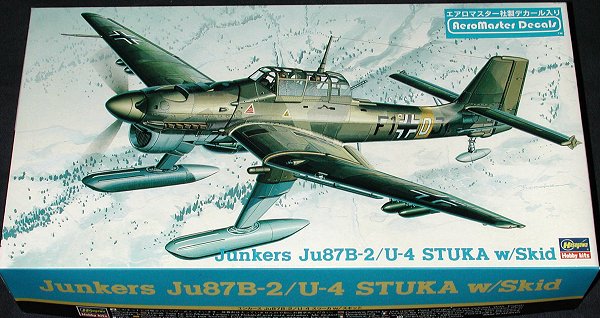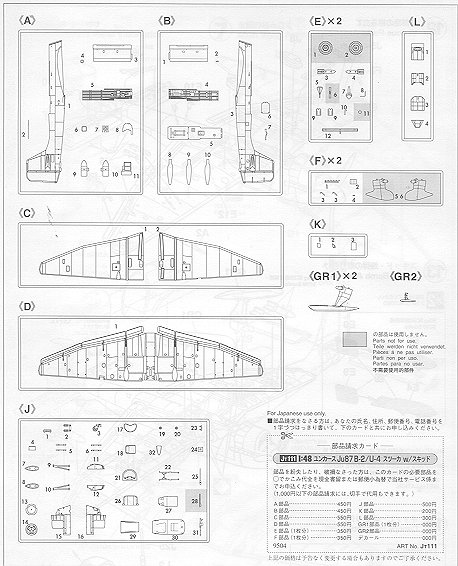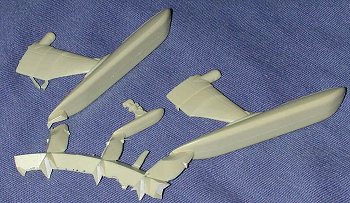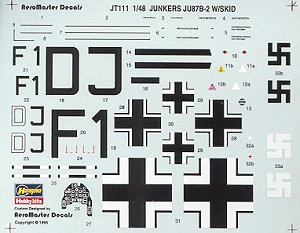
|
KIT: |
Hasegawa 1/48 Ju-87B-2/U-4 |
|
KIT # |
9171 |
|
PRICE: |
$34.95 |
|
DECALS: |
One aircraft |
|
REVIEWER: |
|
|
NOTES: |
Includes resin ski undercarriage |

|
HISTORY |
The Ju-87 was inspired by a visit to the US by Ernst Udet, then a ranking officer in the new Luftwaffe. There he saw demonstrations of a Curtiss Hawk biplane being used as a dive bomber and the German penchant for the type was born. The first really successful German type was the Ju-87. Early versions were tested with much success in Spain during the Spanish Civil war. So impressed were the Germans that they used them to spearhead attacks on Poland and the rest of Europe in the early months of the war. The type was equally as successful during those campaigns. However, a piece of the puzzle was generally missing during those years and that was an effective air defense. When the Ju-87 was used against British targets during the opening phases of the Battle of Britain, the Stuka was proven to be an extremely easy target and Ju-87 units were decimated.
Quickly removed from the battle, these units had a reprieve in North Africa, Greece and against the Soviets where the Germans were able to keep air superiority in the Stuka's area of operation. Despite its growing obsolescence, it was not only continually upgraded, but served well until the final days of the war.
|
THE KIT |

 This is one of the many 'special
boxing' kits that are so prevalent from Hasegawa. In this case, it is the
standard 1/48 Ju-87B kit with the inclusion of a set of resin skis. The first
thing I noticed when I opened the box is that both the kit bag and decal bag had
been opened. Very unusual in a sealed kit. I'm wondering if this is only on my
kit or if others who have this boxing have noticed the same thing. A careful
check of the parts shows that nothing is missing, but it is a bit of a ponder.
The resin parts are very well molded and should present no problems as they are
simple replacements for the wheels. In case you just can't make up your mind,
the fit of the wheels on the one I built many years ago was so tight that I
didn't have to glue them in. You could easily make them interchangeable. I have
only seen one photograph of this variant and the caption stated that a few were
used in
This is one of the many 'special
boxing' kits that are so prevalent from Hasegawa. In this case, it is the
standard 1/48 Ju-87B kit with the inclusion of a set of resin skis. The first
thing I noticed when I opened the box is that both the kit bag and decal bag had
been opened. Very unusual in a sealed kit. I'm wondering if this is only on my
kit or if others who have this boxing have noticed the same thing. A careful
check of the parts shows that nothing is missing, but it is a bit of a ponder.
The resin parts are very well molded and should present no problems as they are
simple replacements for the wheels. In case you just can't make up your mind,
the fit of the wheels on the one I built many years ago was so tight that I
didn't have to glue them in. You could easily make them interchangeable. I have
only seen one photograph of this variant and the caption stated that a few were
used in  the Norway campaign and
were not a success. Oddly, the aircraft definitely has yellow wing-tip
undersides which, to my knowledge, was NOT a marking used in Norway but on the
Russian Front. The instructions also state the the unit is unknown. From my
research, the code F1 was assigned to I./SG 76 until after the fall of France in
July of 1940 when it became III./ SG 77 (SG = Stuka Geschwader).
the Norway campaign and
were not a success. Oddly, the aircraft definitely has yellow wing-tip
undersides which, to my knowledge, was NOT a marking used in Norway but on the
Russian Front. The instructions also state the the unit is unknown. From my
research, the code F1 was assigned to I./SG 76 until after the fall of France in
July of 1940 when it became III./ SG 77 (SG = Stuka Geschwader).
There is basically no difference in this kit and the previous Ju-87B. You have all the bits there to do a standard Stuka should you so wish to do that. However, you'll have to scrounge some other decals as the sheet in the kit is only for this single plane. While on the subject of the decals, they are done by Aeromaster and come complete with an excellent paint and markings placement guide. As with the other B model kits, Hasegawa has provided a paper template to use when doing the splinter camo. I used these on a previous build and found them to be most useful.
|
CONCLUSIONS |
No matter how you build it, this will be a very nice model in the long run. It is chock full of detail and very much looks the part of a Stuka. The added resin skis are such that it will make your Ju-87 a little bit different from what is normally seen.
If you would like your product reviewed fairly and quickly where it will be seen by well over 150,000 visitors a month, please contact me or see other details in the Note to Contributors.